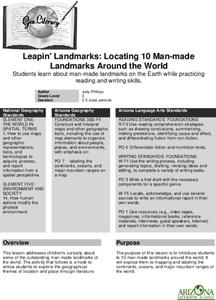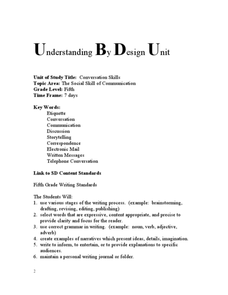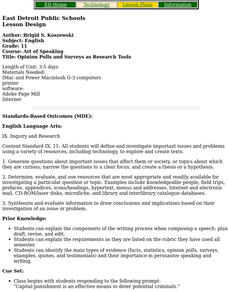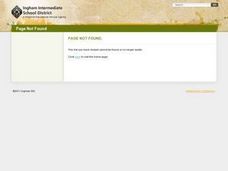Mr. Ambrose
The Great Gatsby, F. Scott Fitzgerald
Good discussion questions, quizzes, and tests teach as well as assess. Readers of The Great Gatsby will learn much from the materials in a 36-page packet designed to help students prepare for the AP Literature exam. Included in the...
Curated OER
Keeping Yourself Organized During Writer's Workshop
Writer's Workshop can be a wonderful way to develop a classroom of authors.
Curated OER
Post-Colonial Writers Unit
How do cultural and historical background impact thought? To explore this essential question, class members view of portion of the film, The Passage to India, read an excerpt from The Magician’s Nephew, and Nissim Ezekiel’s...
Curated OER
Irish Eyes: Taking a Look at Local Landscape
Direct your class’s attention to the elements that make their community unique. After examining sample travel brochures, groups select something from their community to use as the subject, and then research, create, and publish a...
Curated OER
Children Around The World
Students read a multicultural book called "This Is the Way We Go to School" by Edith Baer and Steve Bjorhman. They become culturally aware of the different nationalities around the world and different ways that they may do things on a...
Curated OER
Leapin' Landmarks: Locating 10 man-made landmarks around the world
Third graders engage in a lesson which addresses their curiosity about some of the outstanding people-made landmarks of the world. They explore the geographical themes of location and place through literature.
Curated OER
On The Go! Forces and Motion
Young scholars create a car using physics. In this forces and motion instructional activity, students create a car and test which changes in design change the performance of the car. Young scholars complete a graphic...
Curated OER
Youth Helping to Elevate Awareness
Eighth graders read a book whose main character has a physical disability, and complete various related activities. They listen to a guest speaker, simulate experiences at school as a disabled individual through the use of wheelchairs,...
Curated OER
"A MLA Style of Life"
Students effectively research using the internet, encylopedias, magazines and newspapers. They desegregate into needed and un-needed information based on their research findings. Pupils recognize and appropriately site sources using a...
Curated OER
Double Jeopardy-Homophones
Second graders identify homophones as words that sound alike but have different meanings. They, given a pair of homophones, are to explain the meanings of the words using gestures, role playing, or drawing a picture with their partner.
Curated OER
Character Development Project
Read Dangerous Minds with your language learning disabled pupils to identify characteristics and connect to literature. This is a specific activity intended for use with the suggested book. The class uses a character map as a way...
Curated OER
Literary Analysis of Theme
Remember reading "The Lottery" and "The Possibility of Evil" by Shirley Jackson? Learners can experience and analyze the tension, themes, and human experience found in these pieces through reading and class discussion. They use...
Curated OER
Balancing Equations
Students work in pairs to complete a worksheet that asks them to balance several chemical equations. They partner with other students to correct the equations and then follow online instructions to create a table in Word.
Curated OER
The Social Skill of Communication
Fifth graders explore communication by analyzing manners. In this social skills instructional activity, 5th graders review the different forms of communication and how to present yourself in a phone conversation, face to face meeting,...
Curated OER
PowerPoint Presentation of Fudge Comic Strips
Fourth graders create comic strips for presentation to the class. They make drawings, record them digitally, transfer them to a KidPix program and then arrange them in a PowerPoint presentation in a comic strip format.
Curated OER
Everyone's an Author
Students examine variety of written pieces of quality fiction, discuss what different story elements are present and how those elements make stories as effective as they are, and create a class story.
Curated OER
Technical Literacy
Students explore the components of the transference of technological information through this ten lesson unit. The applications to specific careers, the determination of responsible use of technology, and the affects of technology on...
Curated OER
The Art of Paraphrasing
Tenth graders participate in an activity in which they practice paraphrasing sections of primary and secondary documents. They are to share their paraphrasing with the class to help with their confidence speaking in front of a group.
Curated OER
Lizards
Fourth graders recall lizards from the text and report their important traits. The teacher adds the information to the map. They watch the map expand while it organizes all of the lizards and their characteristics.
Curated OER
Heritage: 'And Should We Die...' Attributes of the Pio
Eighth graders use comprehension strategies after reading to reflect on, consolidate, and extend meaning. They show various attributes of the pioneers through character sketches.
Curated OER
Opinion Polls And Surveys As Research Tools
Eleventh graders determine, evaluate, and use resources that are most appropriate and readily available for investigating a particular question or topic. Examples include knowledgeable people, field trips, prefaces, appendices,...
Curated OER
Poetry for Kids
Sixth graders be immersed indirect experiences which are opportunities for students to reflect, look back, debrief or abstract from their experiences what they have felt, and thought, and studied.
Alabama Learning Exchange
Edible Cell
Young scholars identify cell parts and their function. In this animal cell lesson, students view a video clip and discuss cell components. Young scholars create an edible replica of an animal cell using food items.
Curated OER
Language Arts: Creating Multimedia Reports
Ninth graders create multimedia presentations about their backgrounds and family heritage. They discover how to use the necessary computer skills and practice them in pairs. Students present their projects to the class and have a general...

























